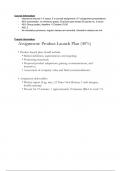Course Information
- Interactive lectures 1-4 cases, 5 is consult assignment, 6-7 assignment presentations
- 60% examination, no minimum grade, 30 points open-ended 30 points mc, 2 hours
- 40% Group project, deadline 11 October 10:00
- WG: 2
- No mandatory presence, regular classes are recorded, interactive classes are not
Project Information
,Lecture 1.
Marketing: performance of business activities designed to plan, price, promote, and direct
the flow of a company’s goods and services to consumers for a profit.
- Strategic aspects;
- Defining the target market
- Defnining the value proposition & positioning
- Tactical aspects;
- Product / Service / Brand
- Pricing & Incentives
- Communications
- Distributions
The Five C’s of the Target Market
1. Context
2. Company
3. Customers → needs & profile
4. Collaborators
5. Competitors
Different target markets require adjustments of the 5 C’s
→ E.g. pizza delivery in Russia is more price-sensitive & low trust in delivery vs. a more
value-conscious market & higher interest in international cuisine in England
Context Analysis → 5 factors
1. Socio-cultural
- Social & demographic trends
- Value systems: religion & language
- Lifestyles, attitudes, beliefs
→ e.g. more woman working, changed attitudes towards delivery and global
cuisines resulting in an increase in deliveries and changing demands
2. Technological
- New techniques, skills, methods, processes for creating and delivering market
offerings
→ e.g. smart-phone changing customer side ordering (custoemrs use
application), changes in internet infrastructure (supplier-side
3. Regulatory
- Taxes, import tariffs, emmbargoes
- Product specifications & requirements
- Pricing & Communication regulations
- IP laws
→ e.g. food safety regulations, work safety regulations, ingredient embargoes
and data sharing and protection regulations.
4. Economic: Economic growth, money supply, inflation, interest rates
5. Physical: Natural resources, climate, geographic location, health trends
,Marketing Strategy: Value
- Value proposition: the value the company aims to create in the target market.
Defined by
1. Customer value: why should consumers spend their money on our product
rather than our other products or products of others?
2. Collaborator value: why should franchisee choose us, and not our
competition or open independent stores?
3. Company value: why should we spend money and hours of employees on
this product rather than another?
International Marketing → presents the company with unfamiliar problems and varying
levels of uncertainty due to performing activities in more than one nation.
Global corporation
- Operates in multiple countries
- Consistent operations at low relative cost as if the entire world is a single entity
- Sells the same things in the same way everywhere
→ standardization: lower prices & greater learning opportunities (specializing in one
thing)
Multinational corporation
- Operates in multiple countries
- Adjusts its products and practices in each → relative high costs
→ adaptation: higher prices & less learning (knowing something about many things)
Cultural Universals:
- Preference for lower prices, advertising elasticity
- Preference for modernity and reliability
- Cosmopolitanism (= concept that emphasizes the idea of a global community and a
sense of belonging to humanity as a whole) as a defining characteristic of all sectors
Levitt (1983): “only global companies will achieve long-term success by concentrating on
what everyone wants, rather than worrying about the details of what everyone thinks they
might like.”
Global brand measures → % of revenue coming from outside of brand’s home region
→ Global ≠ Standardized:
- Toyata: vehicle names, technical details, equipment specs, colors may vary from
country to country. There are differences for a nearly identical product on the global
market.
- Mc Donalds: different burgers across the world
- LV: product & price customization in Japan
, Cultural Universals: Etic vs. Emic
- Constructs that apply equally well to other cultures
- Etic constructs: outsider-in view
- Not equally important, yet equally applicable across cultures
- Survey-based studies with cross-sectional comparison
→ Hofstede’s Cultural dimensions, World Values Survey, Humor, Beauty etc.
- Constructs that apply to a given culture
- Emic constructs: from within view
- Not applicable across cultures
- Determined through perceptions of culture members
→ Guanxi (china), Hygge (Denmark), Non-discrimination
Universal vs. Country-specific Behaviours
- How to assess quality?
- Brand
- Physical features
- Price
- Retailer reputation
→ There are specific behaviors in countries and these are ordered in relative
importance, but this is universal across the world.
Dawar & Parker (1994): RQ: Are there culture-invariant consumer behaviours?
→ Weakness of study is limited N size, and intra-group variances due to the chosen
groupings.





